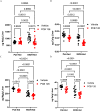Multiomics Analysis of PCB126's Effect on a Mouse Chronic-Binge Alcohol Feeding Model
- PMID: 38619879
- PMCID: PMC11018247
- DOI: 10.1289/EHP14132
Multiomics Analysis of PCB126's Effect on a Mouse Chronic-Binge Alcohol Feeding Model
Abstract
Background: Environmental pollutants, including polychlorinated biphenyls (PCBs) have been implicated in the pathogenesis of liver disease. Our group recently demonstrated that PCB126 promoted steatosis, hepatomegaly, and modulated intermediary metabolism in a rodent model of alcohol-associated liver disease (ALD).
Objective: To better understand how PCB126 promoted ALD in our previous model, the current study adopts multiple omics approaches to elucidate potential mechanistic hypotheses.
Methods: Briefly, male C57BL/6J mice were exposed to polychlorinated biphenyl (PCB) 126 or corn oil vehicle prior to ethanol (EtOH) or control diet feeding in the chronic-binge alcohol feeding model. Liver tissues were collected and prepared for mRNA sequencing, phosphoproteomics, and inductively coupled plasma mass spectrometry for metals quantification.
Results: Principal component analysis showed that PCB126 uniquely modified the transcriptome in EtOH-fed mice. EtOH feeding alone resulted in differentially expressed genes (DEGs), and PCB126 exposure resulted in more DEGs in the EtOH-fed group (907 DEGs) in comparison with the pair-fed group (503 DEGs). Top 20 significant gene ontology (GO) biological processes included "peptidyl tyrosine modifications," whereas top 25 significantly decreasing GO molecular functions included "metal/ion/zinc binding." Quantitative, label-free phosphoproteomics and western blot analysis revealed no major significant PCB126 effects on total phosphorylated tyrosine residues in EtOH-fed mice. Quantified hepatic essential metal levels were primarily significantly lower in EtOH-fed mice. PCB126-exposed mice had significantly lower magnesium, cobalt, and zinc levels in EtOH-fed mice.
Discussion: Previous work has demonstrated that PCB126 is a modifying factor in metabolic dysfunction-associated steatotic liver disease (MASLD), and our current work suggests that pollutants also modify ALD. PCB126 may, in part, be contributing to the malnutrition aspect of ALD, where metal deficiency is known to contribute and worsen prognosis. https://doi.org/10.1289/EHP14132.
Figures





References
MeSH terms
Substances
Grants and funding
LinkOut - more resources
Full Text Sources
Molecular Biology Databases

